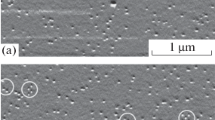Abstract
Single and multilayer sheets of self-assembled CdSe [quantum dots (QDs)] were grown by means of molecular beam epitaxy in both ZnSe and (Zn0.9Mn0.1)Se matrices. Both types of structure were assessed by means of transmission electron microscopy in the scanning, high-resolution, and diffraction-contrast modes. Complementary results from wider sample areas were obtained by means of photoluminescence spectroscopy. In one of the samples analyzed, a fractional monolayer of MnSe was deposited immediately before the CdSe deposition. A second structure grown under identical conditions, but without the MnSe fractional monolayer, was also analyzed. This comparison provides direct evidence for an enhanced size and shape homogeneity of 3D QDs caused by the presence of a tiny amount of MnSe at the interface. In the multilayer structure, we observed the co-existence of highly strained quasi-2D QDs and CdSe rich aggregates with compositional modulations on certain crystallographic planes in close proximity.
Similar content being viewed by others
References
D. Bimberg,Semiconductors 33, 951 (1999).
N.N. Ledentsov, V.M. Ustinov, V.A. Shchukin, V.A. Kop'ev, Zh.I. Alferov, and D. Bimberg,Semiconductors 32:343 (1998).
D. Bimberg, M. grundmann, and N.N. Ledentsov, Quantum Dot Heterostructures (New York: John Wiley & Sons, 1999).
V.A. Schukin and D. Bimberg,Rev. Mod. Phys. 71, 1125 (1999).
R.A. Budiman and H.E. Ruda,J. Appl. Phys. 88, 4586 (2000).
R. Heitz, T.R. Ramachandran, A. Kalburge, Q. Xie, I. Mukhametzhanov, P. Chen and A. Madhukar.Phys. Rev. Lett. 78, 4071 (1997).
A.-L. Barabási,Appl. Phys. Lett. 70, 2565 (1997).
A. Madhukar, Q. Xie, P. Chen, and A. Konkar,Appl. Phys. Lett. 64, 2727 (1994).
D.E. Jesson, G. Chen, K.M. Chan, and S.J. Pennycook,Phys. Rev. Lett. 5156 (1998).
Self-ordering processes can be either conservative or dissipative. An example for conservative self-ordering is the formation of crystalline structures with low energy content at moderately low temperatures. It seems to be arguable whether or not the processes that lead to the formation of semiconductor QDs in certain II–VI and III–V compound semiconductor systems may be classified as belonging to the conservative self-ordering type since they show a very rich phenomenology, e.g., Ref. 6, which depends critically on the growth conditions.
I. Suemune and A. Ishibashi,J. Cryst. Growth 214/215, 1 (2000).
S.H. Xin, P.D. Wang, A. Yin, C. Kim, M. Dobrowolska, J.M. Merz, and J.K. Furdyna,Appl. Phys. Lett. 69, 3884 (1996).
C.S. Kim, M. Kim, S. Lee, J. Kossut, J.K. Furdyna, and M. Dobrowolska,J. Cryst. Growth 214/215, 395 (2000).
J.K. Furdyna,J. Vac. Sci. Technol. A4, 2002 (1986).
M. Keim, M. Korn, F. Bensing, A. Waag, G. Landwehr, S.V. Ivanov, S.V. Sorokin, A.A. Sitnikova, T.V. Shubina, and A.A. Toropov,J. Cryst. Growth 214/215, 684 (2000).
P.D. Nellist and S.J. Pennycook,Ultramicroscopy 78, 111 (1999).
S.J. Pennycook, M.f. Chrisholm, Y. Yan, G. Duscher, and S.T. Pantelides,Phys. B, 273 (1999).
S.J. Pennycook, S.D. Berger, and R.J. Culbertson,J. Microscopy 144, 229 (1986).
S. Lee, I. Daruka, C.S. Kim, A.-L. Barabási, J.L. Merz, and J.K. Furdyna,Phys Rev. Lett. 81, 3279 (1998).
D.J. Hudson,Statistics, Lectures on Elementary Statistics and Probabilities (1964).
D. Bimberg, M. Grundmann, and N.N. Ledentsov,MRS Bulletin 23, 31 (1998).
C.S. Kim, M. Kim, J.K. Furdyna, M. Dobrowolska, S. Lee, H. Rho, L.M. Smith, H.E. Jackson, E.M. James, Y. Xin, and N.D. Browning,Phys. Rev. Lett. 85, 1124 (2000).
N. Carlsson, K. Georgsson, L. Montelius, L. Samuelson, W. Seifert, and R. Wallenberg,J. Cryst. Growth 156, 23 (1995).
In order to explain the observed effects, it was suggested in Ref. 23 that the very thin GaP layer may, although pseudomorphologically strained, lead to partial strain compensation since bulk GaP has a 3.6% smaller lattice constant than (Ga,In)P when it is lattice matched to GaAs. Bulk InP, finally, has a 3.8% larger lattice constant than GaAs. We suspect, however, that static strain considerations may not be sufficient in the above mentioned case23 nor in the presented case of the influence of a fractional monolayer of MnSe on the formation of 3D CdSe QDs, where the strain relations are qualitatively different. Alternatively, we suggest that the self-ordering processes that lead to an improved size and shape homogeneity of 3D CdSe and InP QDs may be of a dissipative nature10 and, therefore, be more successfully described by a dynamic synergistic approach (as already called for by other authors in 19976)—which we are going to outline in forthcoming papers.
P. Möck, G.R. Booker, N.J. mason, E. Alphandéry, and R.J. Nicholas,IEEE Proc. Optoelectron. 147, 209 (2000).
M. Schmidbauer, Th. Wiebach, H. Raidt, M. Hanke, R. Köhler, and H. Wawra,Phys. Rev. B 58, 10523 (1998).
D. Schikora, S. Schwedhelm, D. J. As, K. Lischka, D. Litvinov, A. Rosenauer, D. Gerthsen, M. Strassburg, A. Hoffmann, and D. Bimberg,Appl. Phys. Lett. 76, 418 (2000).
M. Strassburg, Th. Deniozou, A. Hoffmann, R. Heitz, U.W. Pohl, D. Bimberg D. Litvinov, A. Rosenauer, D. Gerthsen, S. Schwedhelm, K. Lischka, and D. Schikora,Appl. Phys. Lett. 76, 685 (2000).
J.Y. Tsao,Materials Fundamentals of Molecular Beam Epitaxy (New York: Academic Press, Inc., 1993), pp. 93–150.
A. Zunger and S. Mahajan,Handbook on Semiconductors, completely revised edition, ed. T.S. Moss, vol. 3B, ed S. Mahajan (Amsterdam: Elsevier Science B.V., 1994), pp. 1399–1514.
K. Park, L. Salamaca-Riba, and B.T. Jonker,Appl. Phys. Lett. 61, 2302 (1992).
P. Möck, T. Topuria, N.D. Browning, G.R. Booker, N.J. Mason, R.J. Nicholas, L.V. titova, M. Dobrowolska, S. Lee, and J.K. Furdyna,Mater. Res. Soc. Symp. 640, 6.3.1 (2000).
P. Möck, T. Topuria, N.D., Browning, G.R. Booker, N.J. Mason, R.J. Nicholas, L.V. Titova, M. Dobrowolska, S. Lee, and J.K. Furdyna,Proc. 6th Int. Symp. on Adv. Phys. Fields, “Growth of Well-defined Nanostructures” (Tsukuba, Japan: National Institute for Materials Science, 2001).
Author information
Authors and Affiliations
Rights and permissions
About this article
Cite this article
Möck, P., Topuria, T., Browning, N.D. et al. Self-ordered CdSe quantum dots in ZnSe and (Zn, Mn)Se Matrices Assessed by transmission electron microscopy and photoluminescence spectroscopy. J. Electron. Mater. 30, 748–755 (2001). https://doi.org/10.1007/BF02665867
Received:
Accepted:
Issue Date:
DOI: https://doi.org/10.1007/BF02665867




